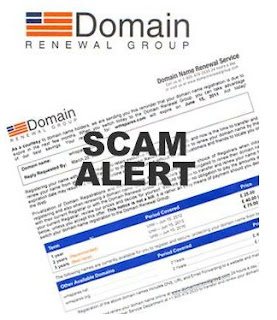This is a guest post compiled by +nesslyn aquino for OgbongeBlog
The internet has always been crowded with all types of scams, from petty small amounts of money to full blown identity theft cases. So we all know that it is important to keep up with the latest ways to protect ourselves and one of the best ways to protect yourself is know exactly how to spot a certain type of scam.
One of the more recent scams that has become popular is the Domain name renewal scams. In this article we will review how it works, warning signs, and how to deal with it.
How it Works
The main goal for the scammers is to get you to pay a renewal fee that really isn't yours and there are two typical types of domain renewal scams.
The first is that the scammer will just end up sending you an invoice that has very small differences in the domain name and hopes that you just end up paying for it without thinking about it twice; also capturing your payment details and personal information as well in the process.
The second type of scam is that you will receive an actual letter or e-mail that looks exactly like your typical invoice and has your actual domain name, but shows a different hosting company. The scammer hopes that you either won't notice the name, or assume that the company re-named itself but is just sending out typical invoices.
Warning Signs
There are easy ways to spot if you are being scammed or not.
If you receive an invoice, double check the actual domain name you are about to renew, make sure that every letter is where it should be. Sometimes they will just switch a letter or two around to make it seem like just a typo.
If the hosting company name is different, make sure to contact them and verify the invoice. You never know, the company might actually be changing its name, but if it's a highly popular hosting company, chances are it is a scam.
Most hosting companies like WebHostingHub offer automatic renewal options, so if you have that applied, you shouldn't be receiving invoices anyways. If you are not on an auto-renewal plan, then most companies will give you months of notice to ensure that you don't lose your valuable domain name from a valid e-mail address.
Another big give away is the actual e-mail address you received the invoice from. If you don't recognize it, just go to your account directly on the website you purchased the domain name from.
Using common sense will go a long ways when it comes to preventing being scammed by these types of situations. Always make sure and review as much information as you can before giving your money away.
What to Do If You Have Already Been Scammed
If you were unfortunate enough to be one of the people who already paid the invoice, don't worry too much because you have options. The first thing you want to do is report the scam. Although it is a well known scam, the more reports it gets, the higher the chance of it being stopped.Second thing to do, is to open a claim with your financial institution. If you used a credit or debit card, most major financial institutions will allow you to open a fraud claim to get your money back. Just because you were scammed doesn't mean you should have to forfeit your money without receiving anything.
Banks are well aware of the scams that happen all over the internet and are willing to help, so let them. If you used other payment types such as E-checks, your bank still might be able to help, so talk to them and keep them informed.
Then the next best thing to do, is to learn from your mistake. This scam isn't usually for a lot of money, so you can learn a lesson and be more vigilant in the future about your payments.
Always make sure that services have been rendered for any payments unless otherwise specified and always check the amounts, merchant information, and your personal information on each invoice. The last thing you want to do is to run into another scammer, only this time for a much larger amount.
This post was written by +nesslyn aquino. She is a writer for MakeAWebsite. Check out their website for more useful tips in making a website.







Thanks for the alert, but please admin which pingger are you using to ping your blog after updates.?
ReplyDeleteping.feedburner.com and pingomatic.com
DeleteI've received such fake notices in the past. Their are also some scammers that will mail you that some companies want to buy the .tk, .hg etc versions of your domain name. If you fall, you will buy domain names you don't need and they might also steal your personal and credit card info.
ReplyDeleteThat's true. One just have to be very careful. Thanks for the contribution.
Deletewaooh! Thanks for exposing them
ReplyDeleteThanks for exposing this criminals. Trying to rob someone off his blog and stuff. I have wesaytech.com
ReplyDelete